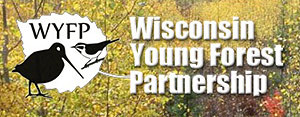 Wisconsin SAF recently joined the Wisconsin Young Forest Partnership (WYFP), a statewide effort to increase the amount of young forest to benefit wildlife, people and forest health and diversity in the Badger State. The concept guiding the WYFP is to create fresh habitat for woodcock and golden-winged warblers, and more than 60 species of wildlife will quickly benefit. Wildlife scientists note that golden-winged warbler and American woodcock numbers have dropped by more than 50 percent across those species’ ranges in recent decades. Conservationists estimate that nearly a million acres of new young forest is needed in Wisconsin alone to restore populations of those two birds to 1970s levels. More common wildlife, such as black bears, whitetail deer, wild turkeys, ruffed grouse, and a host of songbirds also home in on the enhanced food and cover that young forest offers. Songbirds that breed in mature woods take their newly fledged young to feed on the insects and fruits produced abundantly in young forest, where the thick habitat protects the inexperienced youngsters from predators as they grow and develop. And during the fall migration, birds of many species drop in to fuel up on fruits and seeds. The goal of the WYFP is to educate and engage landowners who are not currently managing their forested lands, so that they’ll consider all of their management options and decide to make and enhance young forest for wildlife in appropriate places. Read more about the effort online.
Wisconsin SAF recently joined the Wisconsin Young Forest Partnership (WYFP), a statewide effort to increase the amount of young forest to benefit wildlife, people and forest health and diversity in the Badger State. The concept guiding the WYFP is to create fresh habitat for woodcock and golden-winged warblers, and more than 60 species of wildlife will quickly benefit. Wildlife scientists note that golden-winged warbler and American woodcock numbers have dropped by more than 50 percent across those species’ ranges in recent decades. Conservationists estimate that nearly a million acres of new young forest is needed in Wisconsin alone to restore populations of those two birds to 1970s levels. More common wildlife, such as black bears, whitetail deer, wild turkeys, ruffed grouse, and a host of songbirds also home in on the enhanced food and cover that young forest offers. Songbirds that breed in mature woods take their newly fledged young to feed on the insects and fruits produced abundantly in young forest, where the thick habitat protects the inexperienced youngsters from predators as they grow and develop. And during the fall migration, birds of many species drop in to fuel up on fruits and seeds. The goal of the WYFP is to educate and engage landowners who are not currently managing their forested lands, so that they’ll consider all of their management options and decide to make and enhance young forest for wildlife in appropriate places. Read more about the effort online.
Wisconsin Society of American Foresters
